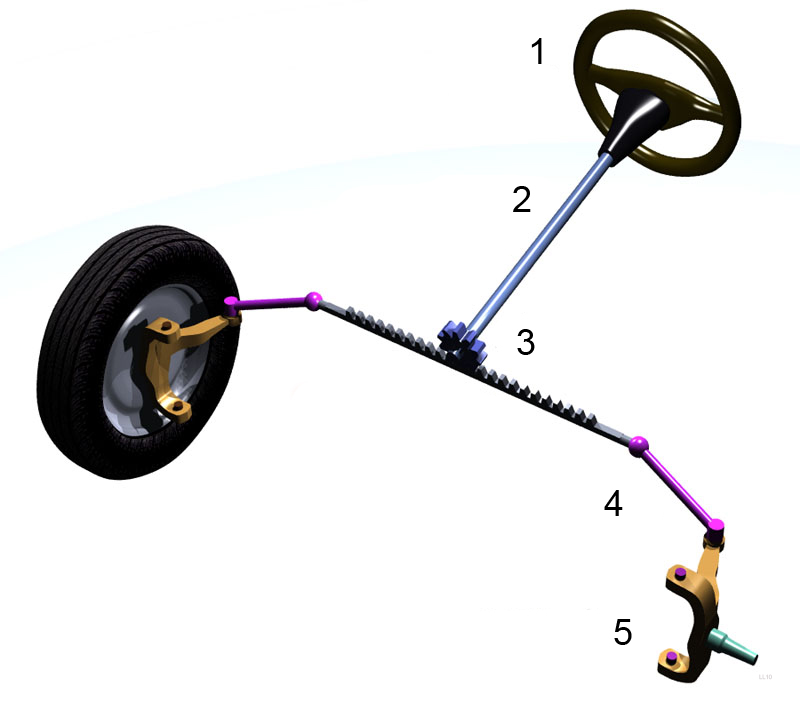[ad_1]
It’s particularly difficult to diagnose steering rack issues. In many situations, people assume the steering rack is the culprit while, in reality, the suspension is to blame. Thus, let’s have a thorough look at what steering rack issues are.

Symptoms of Steering Rack Trouble
As briefly stated, multiple people misinterpret suspension issues as steering rack issues. Issues that manifest solely when the suspension is damaged won’t be mentioned. As such, the common issues are:
- Steering wheel play
- Steering wheel gets stuck
- Hard to turn steering wheel and feels heavy
- You can turn the car more in one direction than the other
- Bumps get transmitted to the steering wheel
- Steering wheel doesn’t sit straight when the wheels are pointing forward
Problems such as the steering wheel not returning to the center after turning, creaks and groans, uneven tire wear, and instability at high speeds are more often than not suspension-related.
Steering Wheel Play
To check for play, all you have to do is turn on your car and try to turn your wheels by barely touching your steering wheel. The amount of slack you notice in the steering wheel is the play. On vehicles with a hydraulic fuel pump, 4° of play is acceptable, 7° of play is poor, while 10° is too much. Electronically assisted racks should have even less slack.
On some cars, you can adjust the steering rack’s preload. Check your owner’s manual or your car’s service manual to see if the steering wheel slack is adjustable. On the systems involving washers, by using a bigger washer you’re forcing the rack and pinion to mesh tighter, resulting in less movement.
Steering wheel play is normal with age and happens due to regular wear and tear. This is the most common issue regarding the steering rack. The rubber bushings found on your steering column, or its mounting points can also facilitate some of that play. Tie rods or ball joints can create a bit of movement too.
Steering Wheel Gets Stuck
If your steering wheel gets stuck, the steering rack could be the culprit. If the rubber boots that shield the tie rods get ruptured, debris and water can enter inside the rack and wash the grease. Lastly, if left for too long, the rack can corrode and jam.
The steering wheel can also get stuck if the anti-theft protection locks it up, or if there are some issues with the steering column itself. A failed pump shouldn’t under any circumstances lock your steering wheel, even if it’s electric.
Steering Wheel is Hard to Turn, Feels Heavy
Once again, if the rubber boots are punctured and the steering rack rusts or the grease inside is washed, the wheel can feel incredibly heavy if the rust isn’t that significant. If the rack is adjustable, adjusting it too tightly will also result in difficult steering.
However, more often than not, a heavy steering wheel is likely the cause of a steering assistance failure, be it hydraulic or electric. If the electric assistance gives away, you’ll be stuck steering using your own muscles, thus making the car difficult to steer. If you have hydraulic assistance, the pump could have issues, the hydraulic circuit could have a leak or puncture, or the hydraulic fluid might’ve thickened, to name a few.
You Can Turn the Car More in One Direction than the Other
This is a rare occurrence, but a possibility is that the rack itself was so damaged that it broke one or two teeth. Thus, when you reach the missing teeth, the pinion doesn’t have the rack to mesh with. The rack itself could’ve gotten clogged with something and the pinion can get past that debris, or the car could’ve been in a crash that displaced the steering rack and the car was fixed poorly.
However, usually, that’s an alignment issue often related to the tie rods. They could even be damaged or bent. That can also rarely happen if you’ve had some maintenance to the steering wheel itself that displaced a spine cable that connects to the airbag and horn by a spine or two.
Bumps Get Transmitted to the Steering Wheel
If you can feel even the smallest potholes in the steering wheel, some bushings inside the steering rack and column are heavily worn. That can also be the case if a tire is worn, or a rim is bent.
Steering Wheel Doesn’t Sit Straight When the Wheels are Turned Forward
This is usually due to an alignment issue, but it can also happen if the steering rack was displaced in a crash and the car was fixed poorly at the best of times.
Final Thoughts
Steering rack issues are easy to diagnose because there aren’t that many things that can go wrong. Often, there’s a bunch of play, with other issues being incredibly rare or even one-of-a-kind. If you eliminated the possibility of the steering rack, then likely the suspension is the culprit.
References
youcanic.com (2019, December 9). Sign of Steering Rack Failure & Problems. https://www.youcanic.com/article/sign-steering-rack-failure-problems
Bryan Miata. (2018, February 11). Miata Rack Play, Adjust Preload [Video]. YouTube. https://www.youtube.com/watch?v=vAPV7ownWvY
(n.d.). The Importance of Steering and CV Boots. REPCO Authorised Service. https://repcoservice.com/hints-and-tips/the-importance-of-steering-and-cv-boots
See Also — How Does a CVT Work?
Image by LaurensvanLieshout, CC BY-SA 3.0, via Wikimedia Commons
[ad_2]
Source link







